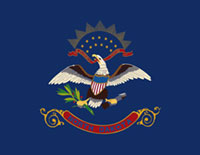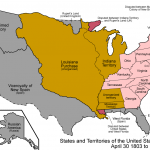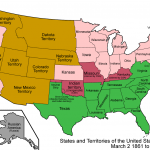Constituting the Peace Garden State
It’s officially nicknamed the Peace Garden State; some folks call it the Flickertail State, after the Richardson ground squirrels that, well, flick their tails, and some call it the Roughrider State because of a 20th-century tourism campaign. Its formal and official name: North Dakota (despite two efforts to drop North and rename the state simply as Dakota).1
 The land that is now North Dakota was originally settled by Native Americans — “the Dakota or Lakota nation, … Assiniboine, Cheyenne, Mandan, Hidatsa, and Arikara. Groups of Chippewa (or Ojibway) moved into the northern Red River valley around 1800, and Cree, Blackfeet, and Crow frequented the western buffalo ranges.”2
The land that is now North Dakota was originally settled by Native Americans — “the Dakota or Lakota nation, … Assiniboine, Cheyenne, Mandan, Hidatsa, and Arikara. Groups of Chippewa (or Ojibway) moved into the northern Red River valley around 1800, and Cree, Blackfeet, and Crow frequented the western buffalo ranges.”2
Europeans reached the area in the 1700s, and all three major European colonizing powers — Great Britain, France, and Spain — claimed sovereignty at one point or another. France initially claimed northeastern North Dakota as part of its Hudson Bay territories, but in 1762 in the secret Treaty of Fontainebleau handed over the colony of Louisiana to Spain.3 The whole of the Louisiana territory was given back to France in 1800 in yet another secret treaty, the Treaty of San Ildefonso.4
 All of which set up France’s sale of the Louisiana Territory to the United States for $15 million — about four cents an acre. The United States Senate ratified the Louisiana Purchase treaty on 20 October 1803,5 an act that literally doubled the size of the United States.6
All of which set up France’s sale of the Louisiana Territory to the United States for $15 million — about four cents an acre. The United States Senate ratified the Louisiana Purchase treaty on 20 October 1803,5 an act that literally doubled the size of the United States.6
And, of course, an act that put most of what later became North Dakota squarely into what was originally the Louisiana Territory and under the governance of that territory.7
 In 1812, when Louisiana was admitted as a State, the territorial area north and west was split off as the Missouri Territory,8 which gained in size in 1818 when Britain ceded all of the lands south of the 49th parallel — including parts of what are now North and South Dakota — to the United States.9
In 1812, when Louisiana was admitted as a State, the territorial area north and west was split off as the Missouri Territory,8 which gained in size in 1818 when Britain ceded all of the lands south of the 49th parallel — including parts of what are now North and South Dakota — to the United States.9
 The area continued to be called the Missouri Territory until the admission of Missouri as a state in 1821, at which point most of the Great Plains were unorganized territory.10
The area continued to be called the Missouri Territory until the admission of Missouri as a state in 1821, at which point most of the Great Plains were unorganized territory.10
Then in 1861, the Dakota Territory was formed.11 By 1863, the Idaho Territory split off and Bismarck became the capital; by 1868, the Wyoming Territory split off as well and the territory was reduced in size to what is today North and South Dakota.12
 Two things spurred development in the Dakota Territory: the passage of the 1862 Homestead Act, which took effect 1 January 186313; and the coming of the rails — particularly the Northern Pacific Railway — in 1872-1873. Fargo, later the capital of South Dakota [editor’s note: no, it wasn’t, and I knew that, really I did], and Bismark, later the capital of North Dakota, got their real starts as railroad towns.14 By the 1880s, the people of the territory felt themselves ready for statehood.
Two things spurred development in the Dakota Territory: the passage of the 1862 Homestead Act, which took effect 1 January 186313; and the coming of the rails — particularly the Northern Pacific Railway — in 1872-1873. Fargo, later the capital of South Dakota [editor’s note: no, it wasn’t, and I knew that, really I did], and Bismark, later the capital of North Dakota, got their real starts as railroad towns.14 By the 1880s, the people of the territory felt themselves ready for statehood.
After initial rejections of the idea, on 22 February 1889, Congress authorized the people of Montana, North Dakota, South Dakota, and Washington to write constitutions in preparation for statehood.15
 And on 2 November 1889, North and South Dakota were admitted to the United States, with North Dakota the 39th state and South Dakota the 40th.16
And on 2 November 1889, North and South Dakota were admitted to the United States, with North Dakota the 39th state and South Dakota the 40th.16
And in between those two dates, the people of North Dakota adopted the one and only constitution that state has ever had. Some 75 delegates from 25 districts were elected on 14 May and convened in Bismarck on 4 July. The end result was presented to the voters and approved by a wide margin on 1 October 1889.17
Among the provisions of the lengthy document — the 1889 constitution as adopted contained 20 articles and 217 sections, plus a schedule of 26 transitional sections to aid in the transition from territory to state18 — were provisions that:
• “The state of North Dakota is an inseparable part of the American Union and the Constitution of the United States is the supreme law of the land.”19
• The legislature contained two houses: a Senate with 30-50 members elected for four-year terms; and a House of Representatives with 60-140 members elected for two-year terms.20
• Any legislator offering to swap his vote on one bill for someone else’s vote on another bill was guilty of soliciting a bribe.21
• The legislature was barred from passing any of 35 different types of local or special laws ranging from emancipating a minor to regulating interest rates.22
• Voting in regular elections was limited to men including “(c)ivilized persons of Indian descent”23 but the legislature was empowered to make further extensions of suffrage including to women thereafter if approved by popular vote24 and women could not only vote in school elections but could be elected to school offices.25
• Free public schools “open to all children of the State of North Dakota and free from sectarian control” were mandated with instruction “to impress upon the mind the vital importance of truthfulness, temperance, purity, public spirit, and respect for honest labor of every kind.”26
• Property taxes were limited to four (4) mills on the dollar27 and a poll tax was allowed of not more than $1.50 on “every male inhabitant of this State over twenty-one and under fifty years of age, except papers, idiots, insane persons and Indians not taxed.”28
• “The labor of children under twelve years of age” was “prohibited in mines, factories and workshops” in North Dakota.29
Overall, the 1889 constitution was six times as long as the U.S. Constitution and created a weak Governor with many elected statewide officials. By 1970 it had been amended more than 90 times and voters approved a constitutional convention to revise it. But at the polls in 1972, they rejected the new constitution that resulted, and so the 1889 constitution as amended remains in effect.30
The Constitution as adopted is available online, among other resources, at Google Books in the State of North Dakota 1889-90 Legislative Manual at pages 76-142.
As amended to today, it’s available as a PDF file from the North Dakota Legislature.
SOURCES
Images courtesy of user Golbez, Wikimedia Commons
- “Nicknames,” North Dakota.gov (http://www.nd.gov/ : accessed 11 Jul 2012). ↩
- Larry Remele, “Summary of North Dakota History – First People,” State Historical Society of North Dakota, North Dakota.gov (http://history.nd.gov : accessed 11 Jul 2012). ↩
- “Louisiana as a Spanish Colony,” Louisiana: European Explorations and the Louisiana Purchase, Library of Congress, American Memory (http://memory.loc.gov/ammem/index.html : accessed 11 Jul 2012). ↩
- “Preliminary and Secret Treaty between the French Republic and His Catholic Majesty the King of Spain, Concerning the Aggrandizement of His Royal Highness the Infant Duke of Parma in Italy and the Retrocession of Louisiana,” Treaty of San Ildefonso : October 1, 1800; html version, Yale Law School, Avalon Project (http://avalon.law.yale.edu : accessed 11 Jul 2012). ↩
- Journal of the Executive Proceedings of the Senate of the United States of America, vol. 1 (Washington, D.C. : Duff Green, 1828), 450 ; digital images, “A Century of Lawmaking for a New Nation: U.S. Congressional Documents and Debates, 1774-1875,” Library of Congress, American Memory (http://memory.loc.gov/ammem/index.html : accessed 11 Jul 2012). ↩
- “Louisiana Purchase,” Primary Documents in American History, Library of Congress (http://www.loc.gov : accessed 11 Jul 2012). ↩
- “An Act erecting Louisiana into two territories, and providing for the temporary government thereof,” 2 Stat. 283 (1804); digital images, “A Century of Lawmaking for a New Nation: U.S. Congressional Documents and Debates, 1774-1875,” Library of Congress, American Memory (http://memory.loc.gov/ammem/index.html : accessed 25 Jun 2012). See also “An Act further providing for the government of the district of Louisiana,” 2 Stat. 331 (1805). ↩
- “An act providing for the government of the territory of Missouri,” 2 Stat. 743 (1812). ↩
- Wikipedia (http://www.wikipedia.com), “Treaty of 1818,” rev. 3 Jul 2012. ↩
- Wikipedia (http://www.wikipedia.com), “Missouri Territory,” rev. 4 Jun 2012. ↩
- “An Act to provide a temporary Government for the Territory of Dakota,” 12 Stat. 239 (1861). ↩
- Wikipedia (http://www.wikipedia.com), “Dakota Territory,” rev. 7 Jul 2012. ↩
- “An Act to secure Homesteads to actual Settlers on the Public Domain,” 12 Stat. 392 (20 May 1862). ↩
- Remele, “Summary of North Dakota History – American Settlement.” ↩
- 26 Stat. 676 (22 Feb 1889). ↩
- “Today in History : November 2,” Library of Congress, American Memory (http://memory.loc.gov/ammem/index.html : accessed 11 Jul 2012). ↩
- “Constitutional Convention, 1889,” Archives – State Agencies – Constitutional Convention, 1889, State Historical Society of North Dakota, North Dakota.gov (http://history.nd.gov : accessed 11 Jul 2012). ↩
- Constitution of the State of North Dakota, 1889, in State of North Dakota 1889-90 Legislative Manual (Bismarck, N.D. : Daily Tribune, printers, 1890), 76-142; digital images, Google Books (http://books.google.com : accessed 11 Jul 2012). ↩
- Ibid., Article I, § 3. ↩
- Ibid., Article II. ↩
- Ibid., Article II, § 40. ↩
- Ibid., Article II, §. 69. ↩
- Ibid., Article V, § 121. ↩
- Ibid., Article V, § 122 ↩
- Ibid., Article V, § 128. ↩
- Ibid., Article VII, §§ 147-148. ↩
- Ibid., Article XI, § 174. ↩
- Ibid., Article XI, § 180. ↩
- Ibid., Article XVII, § 209. ↩
- See Dr. D. Jerome Tweton, Voters Reject New Constitution by Overwhelming Margin, The North Star Dakotan, 14 Apr 1972; html reprint, North Dakota Studies (http://www.ndstudies.org : accessed 11 Jul 2012). ↩



Can Fargo ever have been the capital of South Dakota?? As a former resident of this oddly-named northern state I find this hard to believe. I did not grow up in South Dakota, however, thus did not have the benefit of 3rd grade “History of our state” etc. in school, so if The Legal Genealogist can find a citation for the statement “Fargo [was] later the capital of South Dakota…” I’ll believe it.
Oh drat. I thought I had edited that out. Sigh… You’re right, of course. Ten lashes with a wet noodle, minimum, for that mistake!